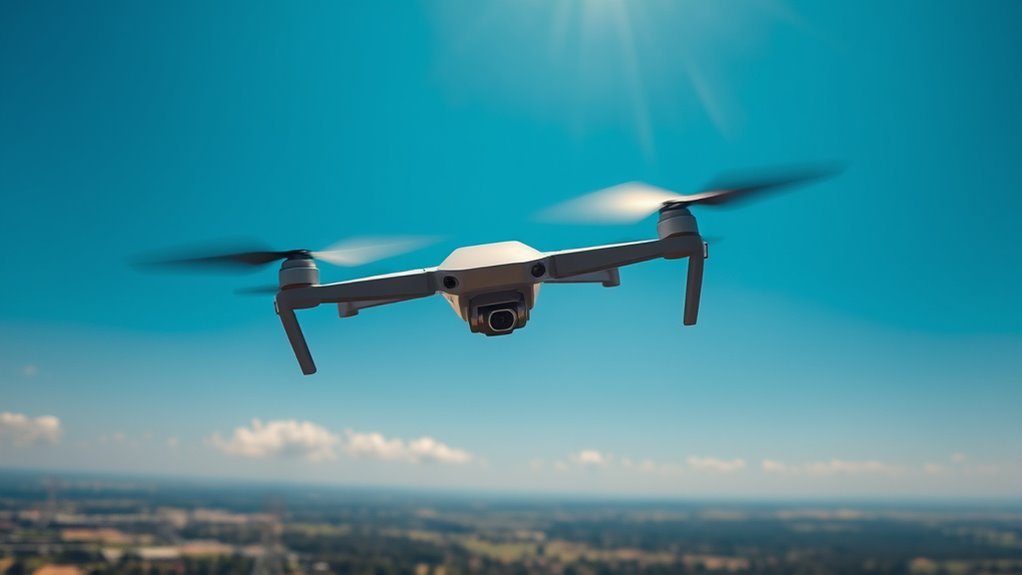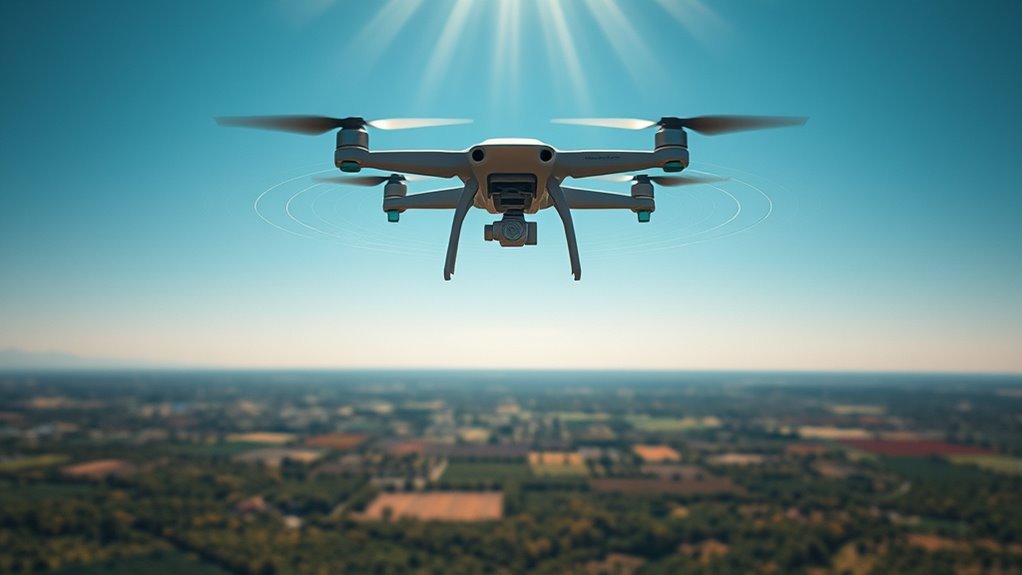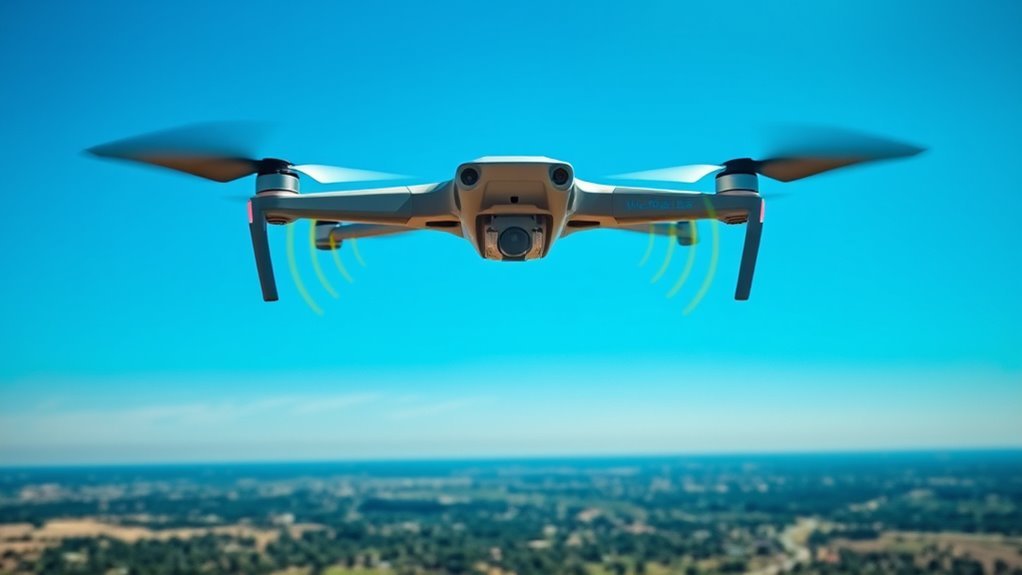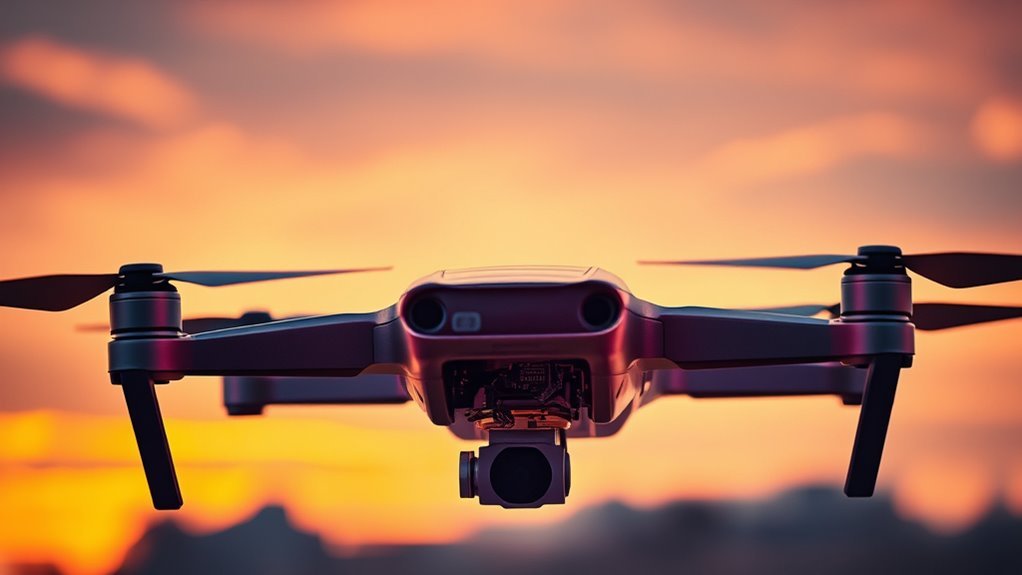You’ll find most drones operate primarily on the 2.4 GHz and 5.8 GHz frequency bands, balancing range, data throughput, and interference. The 2.4 GHz band offers better obstacle penetration and reliable control signals, while 5.8 GHz suits high-definition video transmission with less congestion but shorter range. Some drones also use 900 MHz for longer-range operations. As emerging millimeter wave technologies and regulatory shifts evolve, understanding these frequencies becomes critical for optimizing performance and compliance—exploring further reveals these complexities and future trends.
Overview of Drone Communication Systems

Although drone communication systems vary widely depending on application and range, they fundamentally rely on specific frequency bands to guarantee reliable control and data transmission. When you operate a drone, you’re engaging with complex drone communication protocols that use signal modulation techniques to optimize bandwidth and reduce interference. These modulation schemes—such as Frequency Shift Keying (FSK) or Quadrature Amplitude Modulation (QAM)—ensure your commands and telemetry data maintain integrity across the airwaves. By understanding how signal modulation affects communication robustness and latency, you gain the freedom to select or design systems tailored to your operational needs. Precision in this communication layer is critical, as any disruption can compromise control, data fidelity, and ultimately your autonomy in drone operation.
Common Frequency Bands Utilized by Drones

You’ll find that most drones operate on the 2.4 GHz and 5.8 GHz frequency bands due to their balance of range and data throughput. These frequencies offer reliable communication but can be crowded, leading to potential interference. Emerging frequency options are being explored to address congestion and enhance performance in complex environments.
2.4 GHz Band
When operating drones, you’ll often encounter the GHz frequency bands, which are favored for their balance between range and data transmission capabilities. The GHz band offers several advantages: it supports higher data rates essential for real-time video streaming and control, and it experiences moderate interference compared to lower frequency bands. However, the GHz band also has disadvantages. Its higher frequency results in reduced penetration through obstacles like trees or buildings, limiting operational range in cluttered environments. Additionally, atmospheric absorption at these frequencies can affect signal reliability under adverse weather conditions. Understanding these ghz advantages and ghz disadvantages helps you optimize drone performance based on your operational environment, ensuring you maintain both freedom of movement and control precision without unnecessary compromises.
5.8 GHz Band
Three primary GHz frequency bands dominate drone operations: 2.4 GHz, 5.8 GHz, and 900 MHz, each offering distinct trade-offs in range, penetration, and interference susceptibility. When you choose a drone frequency in the 2.4 GHz band, you benefit from balanced signal propagation with moderate range and good obstacle penetration, though it’s more crowded due to Wi-Fi and Bluetooth devices. The 5.8 GHz band provides higher data rates and less interference but suffers from reduced range and poorer obstacle penetration because of its higher frequency. The 900 MHz band offers superior penetration and longer range, ideal if you prioritize freedom of movement through challenging environments; however, it often supports lower data rates. Selecting the right GHz band is essential to optimizing your drone’s communication and control.
Emerging Frequency Options
Although traditional frequency bands like 2.4 GHz, 5.8 GHz, and 900 MHz remain prevalent, emerging frequency options are gaining traction to meet the growing demands of drone applications. These frequency innovations leverage emerging technologies to enhance range, reduce interference, and improve data throughput, granting you more operational freedom. Consider these promising alternatives:
- 60 GHz Band – Offers ultra-high bandwidth and low latency, ideal for high-definition video transmission but limited by shorter range.
- Sub-6 GHz 5G Spectrum – Provides improved penetration and connectivity, enabling drones to integrate with cellular networks for extended control.
- CBRS (3.5 GHz Band) – A shared spectrum that balances range and bandwidth, supporting commercial drone operations with reliable, low-latency communication.
The 2.4 GHz Band and Its Applications

The 2.4 GHz band is one of the most widely used frequency ranges for drone communication and control due to its balance between range and data throughput. When you operate your drone on this band, you benefit from robust drone connectivity that supports reliable command transmission and real-time telemetry. The band’s relatively lower frequency compared to higher bands allows for better signal strength over obstacles and moderate distances, enhancing your operational freedom. However, the 2.4 GHz spectrum is often congested, shared with Wi-Fi and other devices, which can cause interference. To maximize performance, your drone’s system typically uses frequency hopping and error correction techniques, maintaining a stable link. This makes 2.4 GHz ideal for control signals where consistent connectivity is critical for safety and responsiveness.
The 5.8 GHz Band for Video Transmission
While the 2.4 GHz band excels in control signal reliability, you’ll often find the 5.8 GHz band preferred for drone video transmission due to its higher bandwidth capacity. This frequency supports superior video quality but comes with trade-offs in transmission range and signal interference susceptibility. When optimizing your drone’s 5.8 GHz link, consider these factors:
- Video quality: The wider bandwidth enables high-definition, low-latency video feeds, essential for immersive flight experiences.
- Transmission range: Although higher frequencies typically reduce range, advanced antenna design can partially offset this limitation.
- Signal interference: The 5.8 GHz band experiences less crowded airspace than 2.4 GHz, reducing interference but requiring precise antenna alignment to maintain signal integrity.
Understanding these elements empowers you to maximize your drone’s video transmission freedom and performance.
Emerging Frequency Bands for Drone Use
You’re seeing increasing interest in millimeter wave frequencies for high-bandwidth drone communications, offering significant data rate improvements. The terahertz spectrum also holds potential for future applications, though technical and atmospheric challenges remain. Meanwhile, updated licensing and regulation frameworks are shaping how these emerging bands can be utilized effectively.
Millimeter Wave Applications
Although millimeter wave (mmWave) frequencies present challenges such as limited range and high atmospheric attenuation, they offer unparalleled bandwidth and data throughput essential for advanced drone applications. When you leverage millimeter wave technology, you tap into drone communication advancements that enable ultra-high-speed data transfer and low-latency control. This is critical when you need:
- Real-time high-definition video streaming for surveillance or inspection.
- Enhanced swarm coordination through rapid data exchange.
- Secure, interference-resistant communication in congested RF environments.
Terahertz Spectrum Potential
As drone technology pushes the limits of data transmission and sensing capabilities, the terahertz spectrum emerges as a promising frontier for communication and imaging applications. You’ll find terahertz applications offer ultra-high bandwidths, enabling rapid data exchange and enhanced resolution for onboard sensors. The spectrum advantages include minimal interference, as terahertz frequencies lie between microwave and infrared bands, where congestion is low. This means you can achieve precise spatial mapping and secure communication links, essential for advanced drone operations requiring autonomy and reliability. However, challenges like atmospheric attenuation limit range, so terahertz use is ideal for short-distance, high-capacity scenarios. Embracing terahertz technology could grant you unprecedented freedom in drone performance, releasing capabilities beyond traditional frequency bands and paving the way for next-generation aerial systems.
Licensing and Regulation Updates
While emerging frequency bands offer exciting opportunities for drone communications, regulatory frameworks are rapidly evolving to address their use. You need to stay informed about licensing requirements and regulatory updates that impact your drone operations, especially as authorities integrate new spectrum allocations. Key considerations include:
- Understanding updated licensing requirements for accessing emerging bands, ensuring compliance without compromising operational freedom.
- Monitoring regulatory updates from bodies like the FCC and international agencies, as they refine spectrum management to balance innovation and interference control.
- Preparing for dynamic changes in frequency allocations that may affect drone communication reliability and legal operation.
Regulatory Considerations for Drone Frequencies
Because drone operations rely heavily on radio frequency communication, you need to understand the regulatory framework governing frequency allocation and usage. Maneuvering through regulatory frameworks requires awareness of spectrum management policies designed to balance freedom and interference prevention. Compliance challenges arise as you must operate within allocated bands, often differing by region.
| Region | Frequency Bands Allowed | Key Regulatory Body |
|---|---|---|
| USA | 2.4 GHz, 5.8 GHz | Federal Communications Commission (FCC) |
| Europe | 2.4 GHz, 5 GHz | European Telecommunications Standards Institute (ETSI) |
| Asia-Pacific | 2.4 GHz, 5.8 GHz, 900 MHz | Various national agencies |
Interference and Signal Challenges in Drone Operations
Although drone communication systems operate within designated frequency bands, you’ll still encounter interference and signal degradation that can compromise control and data transmission. Signal interference and communication challenges arise due to crowded spectra, environmental obstacles, and electromagnetic noise. To maintain operational freedom, consider these critical factors:
- Frequency Congestion: Overlapping signals from Wi-Fi, Bluetooth, and other devices within 2.4 GHz and 5.8 GHz bands increase interference risks, limiting reliable control range.
- Physical Barriers: Buildings, trees, and terrain absorb or reflect radio waves, causing multipath interference and signal fading that degrade communication quality.
- Electromagnetic Noise: Industrial equipment and power lines emit noise that disrupts drone frequency bands, forcing adaptive frequency hopping or power adjustments to sustain connectivity.
Understanding these challenges helps you optimize frequency use and maintain seamless drone operation despite interference constraints.
Future Trends in Drone Frequency Technology
As drone applications expand and regulatory landscapes evolve, you’ll see significant advancements in frequency technology aimed at enhancing communication reliability and spectrum efficiency. Future frequency innovations will leverage dynamic spectrum access, allowing drones to adaptively select ideal bands in real time, minimizing interference and maximizing bandwidth utilization. Drone communication advancements will increasingly incorporate millimeter-wave (mmWave) frequencies, supporting higher data rates for complex tasks like HD video streaming and AI-driven navigation. Additionally, integration of 5G and beyond networks will offer ultra-low latency and improved link stability, critical for beyond-visual-line-of-sight (BVLOS) operations. These trends collectively empower you to operate drones with greater autonomy and freedom, overcoming current spectrum limitations while ensuring compliance with evolving regulatory frameworks. Staying informed on these developments will be essential for maintaining operational edge and spectrum agility.

